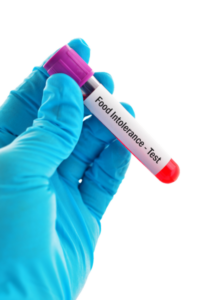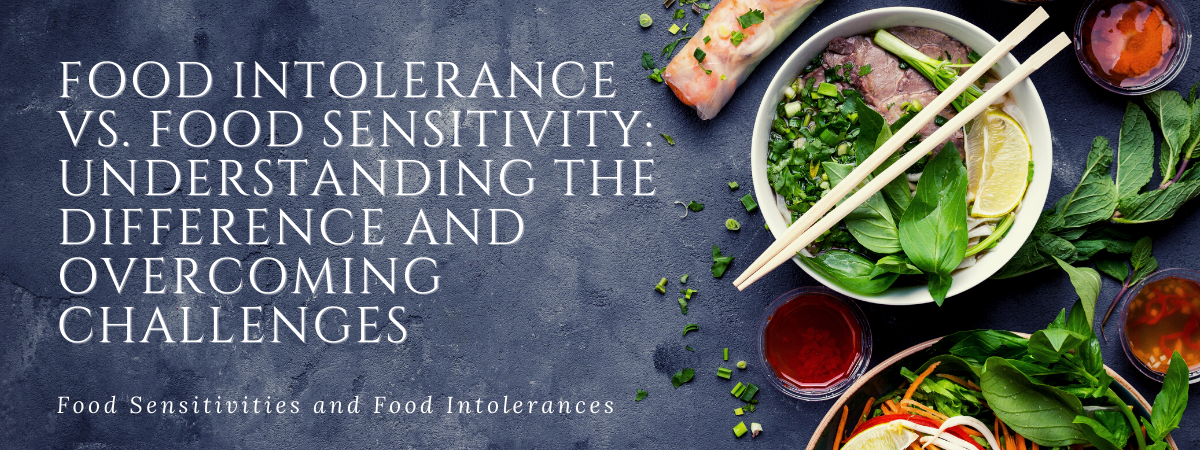Food Intolerance & Sensitivity vs. Food Allergy
In today’s world, the prevalence of food-related issues has significantly increased. Two commonly heard terms are food intolerance and food sensitivity. While they may sound similar, they are distinct conditions with different underlying mechanisms. 15-20% of people experience food sensitivities and intolerances. The pain and discomfort can be invisible and are often misdiagnosed or dismissed despite their severity. In this article, I aim to explain the difference between food intolerance and food sensitivity and explore their causes, symptoms, and potential methods for overcoming these challenges. It should be noted that a food intolerance or food sensitivity is different from a food allergy. A food allergy is much more severe and can be life-threatening. A food allergy happens when your immune system overreacts to a harmless food protein. Common food allergy signs and symptoms include tingling or itching in the mouth, hives, swelling of the face, tongue, and throat, wheezing, nasal congestion, or trouble breathing. It is much more difficult to ascertain a food intolerance or sensitivity since the symptoms are less obvious.
What is a Food Intolerance?
Food intolerance refers to the difficulty in digesting certain types of food due to the absence or insufficiency of specific enzymes. The results in various uncomfortable symptoms, such as bloating, gas, abdominal pain, and diarrhea. Lactose intolerance, for example, occurs when the body lacks the enzyme lactase, which is responsible for breaking down lactose in dairy products. Similarly, gluten intolerance, known as celiac disease, arises from an immune reaction to gluten found in wheat, barley, and rye.
What is a Food Sensitivity?
Food sensitivity, on the other hand, is an adverse reaction to particular food components, often triggered by the immune system. Unlike food allergies, which are immediate and potentially life-threatening, food sensitivities generally manifest as delayed reactions. Symptoms may include headaches, skin rashes, fatigue, joint pain, and digestive disturbances. Common culprits include additives, preservatives, artificial colors, and flavors. Additionally, some individuals may be sensitive to specific natural compounds found in certain foods, such as histamine (a chemical created in the body by white blood cells when the immune system is defending against potential allergens) in aged cheese or tyramine (forms from breakdown of the amino acid tyrosine) in fermented products.
 Food Intolerances Causes and Diagnosis
Food Intolerances Causes and Diagnosis
Food intolerances are primarily caused by genetic factors or conditions that affect enzyme production. Conversely, food sensitivities may arise due to a variety of factors, including leaky gut (a compromised gut barrier), dysbiosis (imbalanced gut microbiota), chronic inflammation, or a weakened immune system. Diagnosing food intolerances typically involves elimination diets or specific medical tests, such as the lactose tolerance test. For food sensitivities, identifying trigger foods can be more challenging due to delayed symptoms, making it necessary to maintain a detailed food diary or undergo specialized testing, such as IgG or IgE blood tests.
Managing The Symptoms of Food Intolerances and Sensitivity
Overcoming food intolerance and sensitivity can be a complex journey that varies from person to person. In the case of food intolerance, managing symptoms often involves avoiding trigger foods or using enzyme replacement therapies. For instance, individuals with lactose intolerance can take lactase supplements to aid in digestion. Similarly, people with gluten intolerance must adhere strictly to a gluten-free diet.
Food sensitivities can be more challenging to overcome, as they often require identifying trigger foods through an elimination and reintroduction process. Once identified, eliminating or minimizing the consumption of trigger foods can alleviate symptoms. Additionally, addressing underlying gut health issues, such as leaky gut syndrome or dysbiosis, through dietary and lifestyle modifications, may help reduce food sensitivities.
Understanding the differences between food intolerance and food sensitivity is crucial for effectively managing these conditions. While complete resolution may not always be possible, individuals can significantly improve their quality of life by identifying trigger foods, making dietary modifications, and addressing underlying gut health issues. Seeking guidance from a registered dietitian can provide valuable support on the journey of overcoming food intolerance and sensitivity. A registered dietitian, especially one that focuses on G.I. health, is highly skilled at using blood tests and elimination diets to diagnose and treat food intolerances and sensitivities. By taking control of their diet and overall health, individuals can find relief from symptoms and enjoy a more fulfilling relationship with food.
Anita Wallak
MS, RD, LDN
Sources:
- Caroline J Tuck, Jessica R Biesierkierski, Peter Schmid-Grendelmeier, David Pohl. Food intolerances. Nutrients. 2019 Jul; 11(7): 1684. Published 2019 Jul 22. doi: 10.3390/nu11071684 PMCID: PMC6682924PMID: 31336652
- GMFH Editing Team. (2018, November 21). Food Sensitivity vs Food Intolerance. Gut Microbiota for Health, European Society of Neurogastroenterology and Motility
- Slazenge, S. (2015, July29). Inflammatory symptoms, immune system, and food intolerance: One cause – many symptoms. Cell Science Systems
- Food intolerance versus food allergy. American Academy of Allergy, Asthma and Immunology. https://www.aaaai.org/Tools-for-the-Public/Conditions-Library/Allergies/Food-Intolerance. Accessed March 9, 2022.



